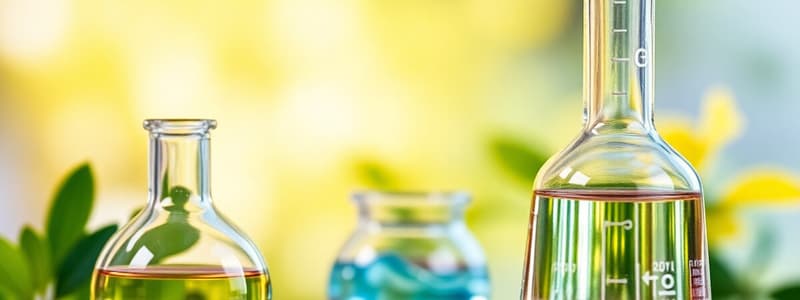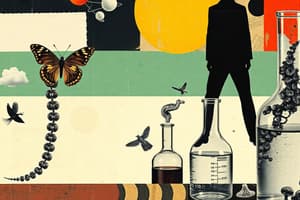Podcast
Questions and Answers
A scientist observes that plants grow taller in sunny areas compared to shady areas. Following the scientific method, what would be the next logical step?
A scientist observes that plants grow taller in sunny areas compared to shady areas. Following the scientific method, what would be the next logical step?
Which of the following is NOT a characteristic shared by all living organisms?
Which of the following is NOT a characteristic shared by all living organisms?
An atom has an atomic number of 6 and an atomic mass of 14. How many neutrons does it have?
An atom has an atomic number of 6 and an atomic mass of 14. How many neutrons does it have?
Which of the following statements accurately describes the role of valence electrons?
Which of the following statements accurately describes the role of valence electrons?
Signup and view all the answers
Why is the 'octet rule' important in understanding chemical bonding?
Why is the 'octet rule' important in understanding chemical bonding?
Signup and view all the answers
Which of the statements accurately describes the relationship between anabolic and catabolic reactions?
Which of the statements accurately describes the relationship between anabolic and catabolic reactions?
Signup and view all the answers
According to the first law of thermodynamics, what happens to energy during a biological process?
According to the first law of thermodynamics, what happens to energy during a biological process?
Signup and view all the answers
How does the second law of thermodynamics relate to biological systems?
How does the second law of thermodynamics relate to biological systems?
Signup and view all the answers
Why is ATP considered the primary energy currency of the cell?
Why is ATP considered the primary energy currency of the cell?
Signup and view all the answers
To effectively prepare for an exam on these topics, which approach would be most beneficial?
To effectively prepare for an exam on these topics, which approach would be most beneficial?
Signup and view all the answers
Which characteristic is NOT shared by all living organisms?
Which characteristic is NOT shared by all living organisms?
Signup and view all the answers
During an experiment, a scientist notices that the data contradicts their initial hypothesis. According to the scientific method, what is the next step?
During an experiment, a scientist notices that the data contradicts their initial hypothesis. According to the scientific method, what is the next step?
Signup and view all the answers
How does increasing the number of neutrons affect an atom?
How does increasing the number of neutrons affect an atom?
Signup and view all the answers
Which type of chemical bond is characterized by the sharing of electrons between two atoms?
Which type of chemical bond is characterized by the sharing of electrons between two atoms?
Signup and view all the answers
What property of water allows insects to walk on its surface?
What property of water allows insects to walk on its surface?
Signup and view all the answers
Which of the following solutions would be considered acidic?
Which of the following solutions would be considered acidic?
Signup and view all the answers
What is the primary function of carbohydrates in living organisms?
What is the primary function of carbohydrates in living organisms?
Signup and view all the answers
Which type of macromolecule is primarily responsible for catalyzing biochemical reactions in cells?
Which type of macromolecule is primarily responsible for catalyzing biochemical reactions in cells?
Signup and view all the answers
What happens to an enzyme when it is denatured?
What happens to an enzyme when it is denatured?
Signup and view all the answers
Which process describes the synthesis of complex molecules from simpler ones, requiring energy input?
Which process describes the synthesis of complex molecules from simpler ones, requiring energy input?
Signup and view all the answers
According to the first law of thermodynamics, what happens to energy in a closed system?
According to the first law of thermodynamics, what happens to energy in a closed system?
Signup and view all the answers
How do buffers stabilize pH levels in biological systems?
How do buffers stabilize pH levels in biological systems?
Signup and view all the answers
Which of the following bonds is the weakest?
Which of the following bonds is the weakest?
Signup and view all the answers
Which property of water is most responsible for the moderation of temperature changes in coastal areas?
Which property of water is most responsible for the moderation of temperature changes in coastal areas?
Signup and view all the answers
Cellulose is a polysaccharide found in plants. What is its primary function?
Cellulose is a polysaccharide found in plants. What is its primary function?
Signup and view all the answers
Flashcards
Characteristics of Life
Characteristics of Life
Living organisms share characteristics such as cell composition, energy requirement, homeostasis, growth, reproduction, responses to stimuli, and evolution.
Scientific Method
Scientific Method
A systematic process for scientific investigation: Observation, Hypothesis, Experiment, Analysis, Conclusion.
Atoms
Atoms
Atoms are the smallest units of matter, composed of protons, neutrons, and electrons.
Valence Electrons
Valence Electrons
Signup and view all the flashcards
Octet Rule
Octet Rule
Signup and view all the flashcards
Catabolic Reactions
Catabolic Reactions
Signup and view all the flashcards
Anabolic Reactions
Anabolic Reactions
Signup and view all the flashcards
First Law of Thermodynamics
First Law of Thermodynamics
Signup and view all the flashcards
Second Law of Thermodynamics
Second Law of Thermodynamics
Signup and view all the flashcards
ATP
ATP
Signup and view all the flashcards
Ionic Bonds
Ionic Bonds
Signup and view all the flashcards
Hydrogen Bonds
Hydrogen Bonds
Signup and view all the flashcards
Cohesion
Cohesion
Signup and view all the flashcards
Adhesion
Adhesion
Signup and view all the flashcards
pH Scale
pH Scale
Signup and view all the flashcards
Buffers
Buffers
Signup and view all the flashcards
Carbohydrates
Carbohydrates
Signup and view all the flashcards
Lipids
Lipids
Signup and view all the flashcards
Proteins
Proteins
Signup and view all the flashcards
Nucleic Acids
Nucleic Acids
Signup and view all the flashcards
Enzymes
Enzymes
Signup and view all the flashcards
Active Site
Active Site
Signup and view all the flashcards
Denaturation
Denaturation
Signup and view all the flashcards
Study Notes
Chapter 1: Introduction to Biology
- Biology studies life, characterized by shared traits
- Living organisms are composed of cells
- Organisms require energy for metabolic processes
- Homeostasis regulates internal conditions
- Growth, development, and reproduction (asexual/sexual) are essential
- Organisms respond to stimuli and evolve over time
- Scientific method: Observation, Hypothesis, Experiment, Analysis, Conclusion
- Molecular and cellular biology is crucial for various fields (medicine, pharmacy, genetics, microbiology)
Chapter 2: Chemistry of Life
Matter and Atoms
- Matter has mass and occupies space
- Atoms are made of protons (+), neutrons (0), and electrons (-)
- Atomic number is the number of protons
- Atomic mass is the sum of protons and neutrons
- Isotopes have the same element but different neutron counts
- Electron shells have fixed electron capacity.
Electron Configuration
- Electrons occupy energy levels (shells)
- Valence electrons, in the outermost shell, dictate chemical behavior
- Octet rule: Atoms (except H and He) seek stability with 8 valence electrons.
Chemical Bonds
- Covalent bonds involve shared electrons (polar/nonpolar)
- Ionic bonds involve electron transfer (forming cations and anions)
- Hydrogen bonds are weak attractions between polar molecules
Properties of Water
- Cohesion (water-water attraction) creates surface tension
- Adhesion (water-other substance attraction) causes capillary action
- High specific heat regulates temperature
- Ice is less dense than liquid water, causing ice to float
- Water dissolves polar and ionic substances (hydration shells), thus serving as a universal solvent.
- Hydrophobic substances repel water, while hydrophilic substances attract water.
pH Scale and Buffers
- pH scale measures H⁺ ion concentration (0-14)
- Acids release H⁺ ions; bases accept them or release OH⁻ ions
- Buffers maintain stable pH by absorbing or releasing H⁺ ions.
Macromolecules
- Carbohydrates: Energy source (monosaccharides, polysacchrides)
- Lipids: Hydrophobic energy storage and membrane components (fats, phospholipids, steroids)
- Proteins: Made of amino acids, perform cellular functions (enzymes, structure, transport).
- Nucleic acids: Store genetic information (DNA and RNA), and ATP (energy carrier).
Enzymes and Metabolism
- Enzymes speed up reactions by lowering activation energy
- Active site is where the substrate binds
- Lock-and-key model describes a precise substrate-enzyme fit
- Denaturation disrupts enzyme function (through changes in temperature or pH)
- Anabolic reactions build molecules, requiring energy; catabolic reactions break down molecules, releasing energy
Thermodynamics in Biology
- First Law: Energy cannot be created or destroyed
- Second Law: Energy transfer increases disorder (entropy)
- Living systems maintain order by constant energy input like ATP production
Quick Review Questions
- Three subatomic particles and their charges: proton (+), neutron (0), electron (-)
- Differences between covalent and ionic bonds: Covalent bonds share electrons, whereas ionic bonds transfer electrons
- Four properties of water supporting life: Cohesion, adhesion, high specific heat, and density properties
- Enzymes’ role in metabolism: Enzymes catalyze reactions by lowering activation energy
- pH definition, and buffer role: pH measures H⁺ concentration; buffers stabilize pH
- Thermodynamics in biology: First law: Energy conservation; Second law: Entropy increase
Study Tips
- Focus on understanding concepts instead of memorizing definitions
- Use flashcards for key terms and macromolecules
- Practice drawing chemical structures and reactions
- Watch animations about enzymes and thermodynamics
- Take practice quizzes for knowledge retention.
Studying That Suits You
Use AI to generate personalized quizzes and flashcards to suit your learning preferences.
Description
Test your knowledge on the fundamentals of biology and chemistry. This quiz covers essential concepts from living organisms, cellular structures, atomic composition, and the scientific method. Perfect for students beginning their studies in the life sciences.




